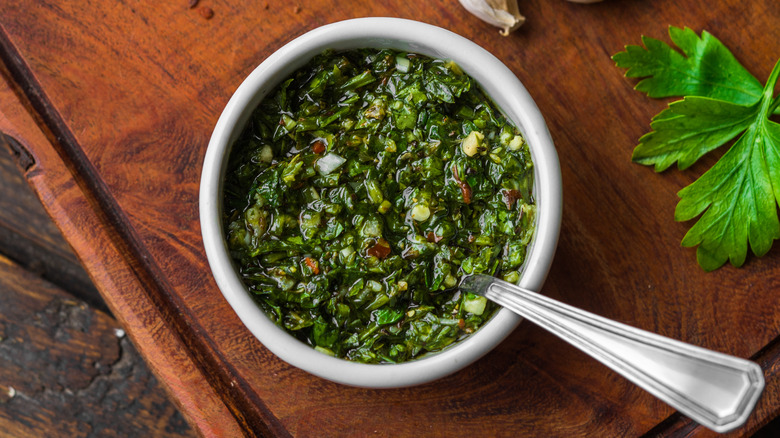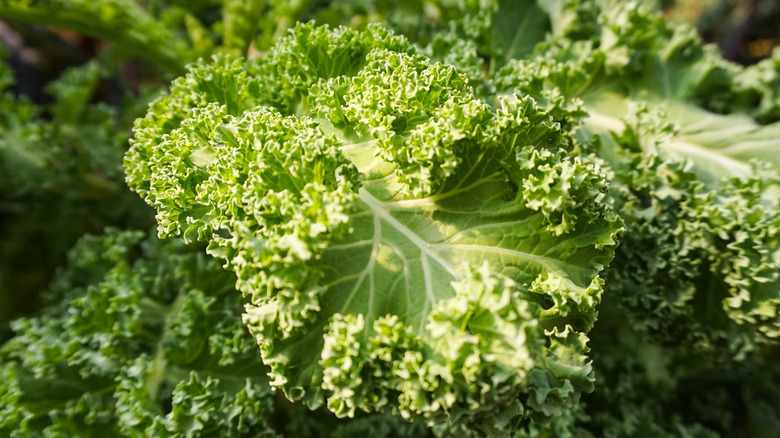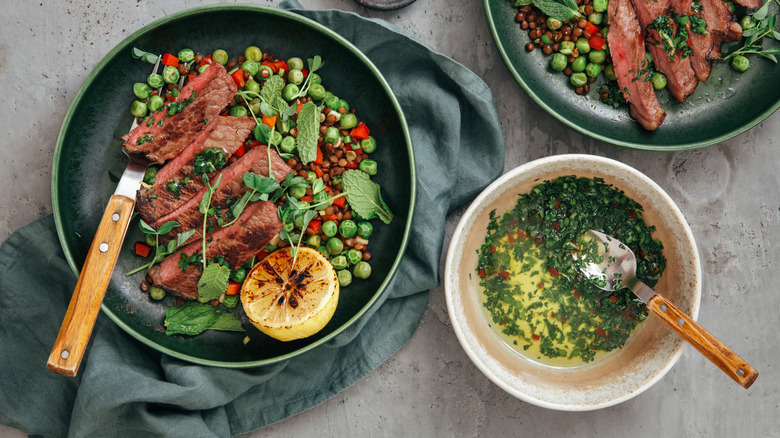Add Kale To Your Chimichurri Sauce For An Earthy Twist On The Classic
Traditional chimichurri sauce, with its dazzling green hue, is a celebration of olive oil, fresh herbs, garlic, and aciditythat's probably best known as a partner to steak, especially in Argentina. Although the origins of chimichurri are somewhat shrouded in mystery, there is no doubt about its versatility on the plate. Its flavor profile features bright parsley, bitter oregano, tangy garlic, smooth olive oil, and either punchy vinegar or subtle citrus notes, that enliven everything from beef to seafood to eggs to pasta.
If you're looking for a way to enhance the earthy tones of your homemade chimichurri, consider adding kale. Kale chimichurri sauce eschews the use of a variety of fresh herbs and instead incorporates kale's tart, peppery flavor, rich with rustic undertones. It takes the bitter edge from oregano and the earthy elements from parsley and ties these flavors together with a texture that's coarse once crushed. Kale also requires minimum preparation, as it can be added raw to a blender or ground with pestle and mortar.
If you are in the mood for a chimichurri sauce with a vibrant, earthy kick along with its classic flavors, kale could be the ideal addition.
A kale primer
Kale is a member of the mustard family, along with cabbage and broccoli. Like these vegetables, there are multiple varieties of kale which have subtle flavor differences. The most common type you're likely to find in grocery stores is curly kale. It has large, frilly-edged leaves that range from pale green hues to shaded deep greens. Typically, this kale is bitter and peppery when eaten raw, which is ideal if you want your chimichurri sauce to have a little bite.
Tuscan kale is milder than curly kale, with a thin leaf and slightly chewy texture. If you're seeking lighter earthy notes for your chimichurri sauce, then Tuscan kale is a great ingredient to build these from. Purple kale, most likely spotted in peak winter, is sweeter than curly or Tuscan kale. Instead of a sharp, peppery flavor profile, purple kale is often likened to the flavor of cabbage, which, while still earthy, does not have the same assertive flavor as other kale varieties.
Finally, baby kale has a soft texture and gentle flavor. For these reasons, baby kale is the least peppery of the kale varieties, so it will work if you want faint earthy tones in your chimichurri sauce. However, baby kale's delicate structure will quickly grind into a mushy paste, which could be a flaw if you want the chimichurri to have a coarse texture.
Kale chimichurri hacks
Chimichurri sauce should sing with the silky flavor of olive oil, and one potential destroyer of this velvety mouthfeel is water. Once you've washed your kale, make sure you dry it thoroughly; you do not want a watery sauce to dilute any of your chimichurri's delicate flavors. Chimichurri sauce also has a coarse texture from the chopped herbs. With kale, it's best to blend or roughly crush the leaves. Otherwise, your sauce could likely turn into a puree.
Classic chimichurri sauce is often used to brighten rich, meaty flavors and delicate cuts of fish. This kale chimichurri can be used in classic dishes like these, but its applications are not tied to the traditional. It can enhance a Caprese salad, beautifully garnish a bowl of pasta, or even add flavor to your morning eggs.
Ultimately, the kale variety you choose will influence the final flavors of your chimichurri sauce. And your chimichurri sauce will enhance the flavors of anything it's served with.


